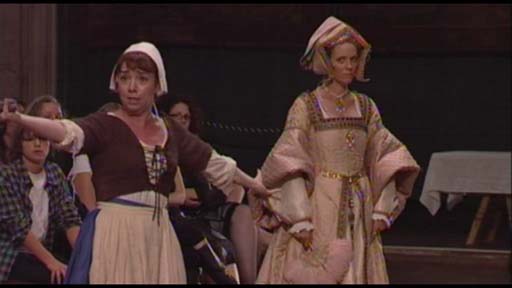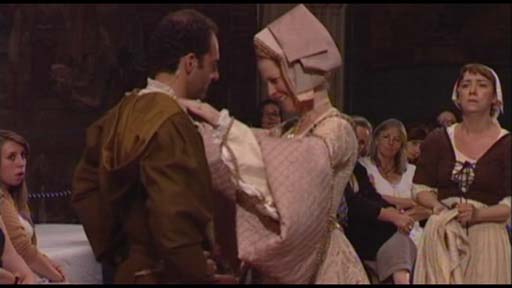Gender, Performance and the Court
Dr Eleanor Rycroft
 Cara Kelly as The Laundress and Sarah Sutcliffe as
The Gentlewoman
Cara Kelly as The Laundress and Sarah Sutcliffe as
The GentlewomanIn a time in which women were denied many rights on financial, legal and social levels, the potential power of performance to deconstruct the stereotyping of gender is especially important. In other words, the representation of women on the stage has the power to expose how their subjugated position in society is linked to their performance of a social role in a culture dominated by the masculine – rather than down to anything naturally or essentially inferior about the female. What is being performed is not biological sex but gender, the social expectations and assumptions about what women are and how they should behave. The male actor who plays the woman’s part during the sixteenth century only serves to highlight the chasm between body and society when it comes to gender. Further, the exhortation for women to be chaste, silent and obedient according to the ideal virtues of femininity at the time, was challenged by the very premise of dramatic performance. Women’s concerns were being represented – albeit by men – and they were shown interacting with males, with all of the comment upon male/female relations that this entailed.
It is often stated as fact that boys played women on Renaissance stages, but there is in fact some evidence to refute this – especially in the drama of the court. Sources such as Hall’s Chronicle demonstrate that women repeatedly took part in courtly performances such as masques, disguisings and pageants during the early Tudor period, and women certainly took part in the masques that were so fashionable at the Jacobean court. While it is the case that these forms of drama rarely contain dialogue, it is difficult to state with absolute certainty that women would never have spoken at the theatrical events that were such a crucial element in the display of power and magnificence at the court. What are we to make of the conversation Catherine of Aragon has with the King and someone dressed as Robin Hood at the Greenwich May Day revels in 1515, for instance? Mary, Henry VIII’s sister, was also "regularly the chief female participant in masks and disguisings at the English court from 1510 to 1514” (2002, 185).
Actor Jenni Maitland on the interaction of the women characters
It is important moreover to widen our notion of performance in line with Shakespeare’s contention that “All the world’s a stage” and realise that cultural life during the Renaissance – particularly when connected to the monarch – was partly a performance, whether that of deference and subservience to the King or Queen, solidarity in front of foreign ambassadors, or an ideal femininity as expressed through virtue and godliness, and gendered activities such as singing and dancing. As the conversation between More and Hythlodaye in Book 1 of Sir Thomas More’s Utopia reveals, to work for a king is to conceal your true motives by playing your part well.
However, it does seem probable that The Play of the Weather would have been performed by either the Gentlemen of the Chapel or the Children of the Chapel – these were the chapel singers who formed part of the retinue of servants at court. There is no record of women performing in ‘interludes’. In a contemporary interlude of the period, Calisto and Melibea, it seems to be suggested that playwrights exploited and audiences enjoyed the disparity between the appearance of the performer and the role they are playing – as the old bawd in the play, Celestina, is called a “beyrded hore” at line 359 and a “berdyd dame” at line 784.
Tom Betteridge and Eleanor Rycroft discussing The Gentlewoman and The Laundress
Evidence pointing towards The Play of the Weather being performed by males is found in the space made for a song by Heywood, as well as an instruction on the title page which directs us more concretely to the Children of the Chapel – specifying that the performer who portrays The Boy must be “the least that can play”. If the actor playing The Boy has to be smaller than the other performers, then there might be taller boys on-stage against which he is to be compared. Either this, or he has been chosen from among the Chapel Children troupe to perform alongside adult males. We do know that women were in the audience for this play, however, as interludes often contain a substantial amount of audience participation, and this can be found written into the texts. In The Play of the Weather, for instance, Merry Report, the clown of the play, makes reference to The Gentleman suitor hunting “a sow or twain out of this sort” (249) – a line which is followed by the stage direction ‘here he poynteth to the women’ revealing it to be a gibe against the females in the audience who are the ‘sows’ and comprise the 'sort' referred to by Merry Report. Indeed this line may even indicate that the audience were segregated along the lines of gender (unless the actor was readily able to find a group of females in the audience against whom to direct the insult) and we utilised this possibility in both the 2009 and 2010 productions. So whether women are directly involved in such performances ceases to matter, they were certainly indirectly involved. The drawing into the performance of female segments of the audience in this and other interludes - Fulgen and Lucres and Like Will to Like for example - shows that females were part of the theatrical spectacle for play-goers at this time. Women were an aspect of the entertainment.
The representation of women in The Play of the Weather hinges on the unusual equation of The Laundress with virtue and The Gentlewoman with sexual laxity. This inverts the traditional ill repute in which laundresses were held1, perhaps partly due to the high degree of mobility they enjoyed in line with their itinerant work, with feminine virtue and chastity being primarily invested in a woman staying indoors and within domestic environments. Yet whereas the Laundress presents an image of her work as a distraction from vice, The Gentlewoman depicts the home as a place of grooming, dancing and singing – all activities that could potentially lead woman down wicked paths, as central as they were to an aristocratic feminine ideal. Heywood can thus be said to present a view of The Laundress which is surprisingly sympathetic in terms of the gender stereotyping of the time. It could be that The Laundress is represented sympathetically because of the potential courtliness of her characterisation, in line with Heywood’s seeming concern to construct positive identities for those characters in The Play of the Weather associated with the court, regardless of class.
Notes:
1. See Carole Rawcliffe, ‘A marginal occupation? The Medieval Laundress and her work’, Gender and History, 21: 1 (April 2009) pp 147-69.
References:
Janette Dillon, Performance and Spectacle in Hall’s Chronicle (London: Society for Theatre Research, 2002).
Three Rastell Plays, Richard Axton, ed. (Cambridge, D.S. Brewer, 1979).












